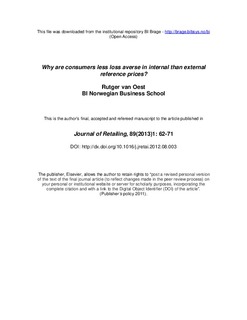| dc.contributor.author | van Oest, Rutger D. | |
| dc.date.accessioned | 2013-04-12T12:19:30Z | |
| dc.date.available | 2013-04-12T12:19:30Z | |
| dc.date.issued | 2013 | |
| dc.identifier.issn | 1873-3271 | |
| dc.identifier.uri | http://hdl.handle.net/11250/93856 | |
| dc.description | This is the author’s final, accepted and refereed manuscript to the article | no_NO |
| dc.description.abstract | The literature has produced mixed support for loss aversion in a reference price context and the outcome may depend on the type of reference price. One extant study has reported empirical evidence that consumers are less loss averse in internal than external reference prices, but without discussing causes or implications. In the current study, we reconcile relevant literature and propose this asymmetric loss aversion result as an empirical generalization. Next, we provide and test an explanation: two empirical regularities in pricing cause that consumers tend to observe few losses for external reference price and many losses for internal reference price, making them less sensitive to internal than external losses. We use two scanner panel data sets to show that the two empirical regularities contribute to asymmetric loss aversion, while accounting for alternative explanations. We explore the implications of loss aversion asymmetry for the effectiveness of price promotions by simulation. | no_NO |
| dc.language.iso | eng | no_NO |
| dc.publisher | Elsevier | no_NO |
| dc.subject | Internal reference price | no_NO |
| dc.subject | External reference price | no_NO |
| dc.subject | Loss aversion | no_NO |
| dc.subject | Scanner panel data | no_NO |
| dc.title | Why are consumers less loss averse in internal than external reference prices? | no_NO |
| dc.type | Journal article | no_NO |
| dc.type | Peer reviewed | no_NO |
| dc.source.pagenumber | 62-71 | no_NO |
| dc.source.volume | 89 | no_NO |
| dc.source.journal | Journal of Retailing | no_NO |
| dc.source.issue | 1 | no_NO |
| dc.identifier.doi | http://dx.doi.org/10.1016/j.jretai.2012.08.003 | |
